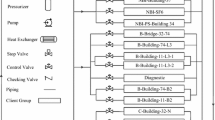Abstract
Two different flow channel configurations on thermal resistances associated with the behavior of cooling of power device were studied in this paper. ANSYS Icepak 14.0 has been adopted as a numerical simulation tool. The simulation results from this study showed that the shapes of channels in cooling radiator play an important role in the thermal management of water cooling radiation system. The optimal channel design could improve the heatdissipating efficiency by 80% in water cooling radiation system. The result also indicated that the thermal resistance of heat sinks decreased with the volumetric flow rate and the number of cylindrical columns in the flow channel. Experimental results were obtained under certain channel configurations and volume rates. Moreover, the results of numerical simulation can be explained well by the experimental results.
Similar content being viewed by others
References
Sublemontier O, Lacour F, Leconte Y, Herlin-Boime N, Reynaud C. CO2 laser-driven pyrolysis synthesis of silicon nanocrystals and applications. Journal of Alloys and Compounds, 2009, 483(1–2): 499–502
Kawashima Y. Proposal of a synchrotron radiation facility to supply ultraviolet light, X-ray, MeV-Photon, GeV-photon and neutron. In: Proceedings of FLS. 2006, WG112
Hoshino H, Suganuma T, Asayama T, Nowak K, Moriya M, Abe T, Endo A, Sumitani A. LPP EUV light source employing high-power CO2 laser. Proceedings on Advanced Lithography Technologies, 2008, 6921: 692131
Banna S, Berezovsky V, Schächter L. Particle acceleration by stimulated emission of radiation: theory and experiment. Physical Review E: Statistical, Nonlinear, and Soft Matter Physics, 2006, 74 (4 Pt 2): 046501–046514
Radivojevic Z, Andersson K, Bielen J A, van der Wel P J, Rantala J. Operating limits for RF power amplifiers at high junction temperatures. Microelectronics and Reliability, 2004, 44(6): 963–972
Van Wyk J D, Lee F C. Power electronics technology at the dawn of the new millennium-status and future. In: Proceedings of IEEE Power Electronics Specialists Conference. 1999, 1: 3–12
Bar-Cohen A, Iyengar M. Design and optimization of air-cooled heat sinks for sustainable development. IEEE Transactions on Components and Packaging Technologies, 2002, 25(4): 584–591
Ozturk E, Tari I. Forced air cooling of CPUs with heat sinks: a numerical study. IEEE Transactions on Components and Packaging Technologies, 2008, 31(3): 650–660
Zhang H, Liu J J, Li Y, Yao S C. Porous media modeling of twophase micro-channel cooling of electronic chips with non-uniform power distribution. In: Proceedings of the American Society of Mechanical Engineers. 2013, 64481–64491
Lee T. Design optimization of an integrated liquid-cooled IGBT power module using CFD technique. IEEE Transactions on Components and Packaging Technologies, 2000, 23(1): 55–60
Moores K A, Joshi Y K, Schiroky G H. Thermal characterization of a liquid cooled AlSiC base plate with integral pin fins. IEEE Transactions on Components and Packaging Technologies, 2001, 24(2): 213–219
Zhao D, Tan G. A review of thermoelectric cooling: Materials, modeling and applications. Applied Thermal Engineering, 2014, 66 (S1–2): 15–24
Yakhot V, Orszag S A. Renormalization group analysis of turbulence. I. Basic theory. Journal of Scientific Computing, 1986, 1(1): 3–51
Patankar S V. Numerical Heat Transfer and Fluid Flow. New York: Hemisphere Publishing Corporation, 1980, 36–78
Versteeg H K, Malasekera W. An Introduction to Computational Fluid Dynamics (The Finite Volume Method). London: Addison Wesley Longman Limited, 1995, 57–89
Hasan M I. Investigation of flow and heat transfer characteristics in micro pin fin heat sink with nanofluid. Applied Thermal Engineering, 2014, 63(2): 598–607
Yu X, Feng J, Feng Q, Wang Q. Development of a plate-pin fin heat sink and its performance comparisons with a plate fin heat sink. Applied Thermal Engineering, 2005, 25(2–3): 173–182
Microsemi. User Manual for DRF 1201 1, 2009
Author information
Authors and Affiliations
Corresponding author
Additional information
Heng Zhao is a Ph.D. candidate in the School of Optical and Electronic Information of Huazhong university of Science and Technology in Wuhan, Hubei, China. He received his B.S. degree in Huazhong University of Science and Technology. His current research interests include high power gas laser, integration of high power laser processing system and RF power amplifier.
Wenjin Wang is a Ph.D. candidate, whose interests include research on a high-power CO2 laser system design and optimization, gas discharge stability, and the kinetic modeling. Wang is with the School of Optical and Electronic Information, Huazhong University of Science and Technology, Wuhan, China.
Yi Hu is a Ph.D. candidate in the School of Optical and Electronic Information of Huazhong university of Science and Technology in Wuhan, Hubei, China. She received her B.S. degree in Huazhong University of Science and Technology. Her current research interests include laser physics, laser optics, and high power laser industrial application.
Youqing Wang is a Professor and doctoral advisor, who has long been engaged in basic research on a high-power CO2 laser and applied research on laser processing material. Wang is with the College of Optoelectronic Science and Technology, Huazhong University of Science and Technology, Wuhan, Hubei, China.
Rights and permissions
About this article
Cite this article
Zhao, H., Li, B., Wang, W. et al. Water cooling radiator for solid state power supply in fast-axial-flow CO2 laser. Front. Optoelectron. 9, 585–591 (2016). https://doi.org/10.1007/s12200-015-0502-2
Received:
Accepted:
Published:
Issue Date:
DOI: https://doi.org/10.1007/s12200-015-0502-2




